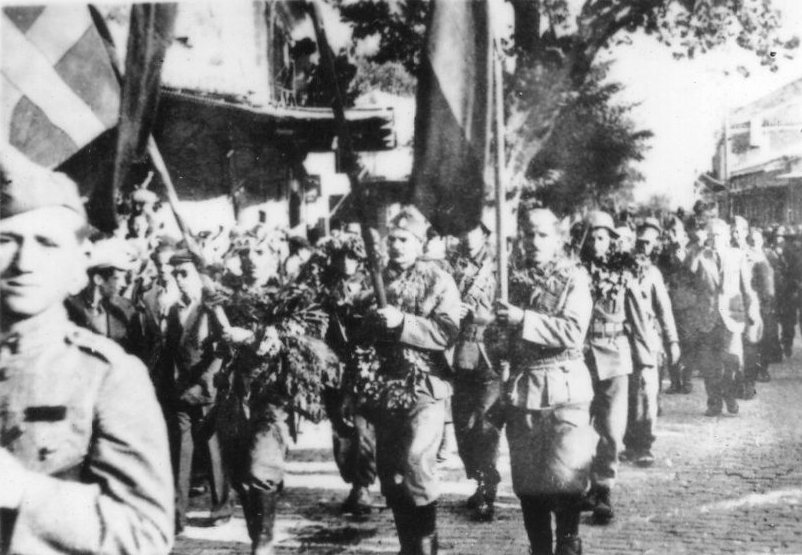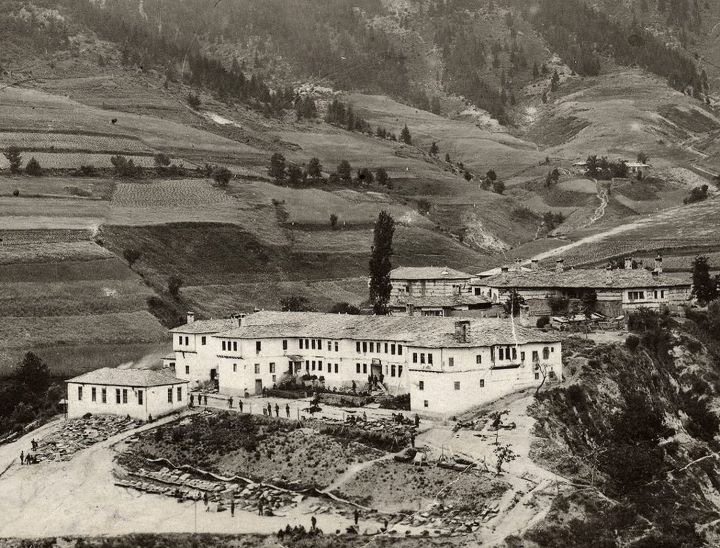|
Sanjak Of Gümülcine
The Sanjak of Gümülcine ( Ottoman Turkish: ''Sancak-i Gümülcine'', el, Υποδιοίκησις Γκιουμουλτζίνας, bg, Гюмюрджински санджак) was a second-level province (''sanjak'') of the Ottoman Empire in Thrace, forming part of the Adrianople Vilayet. Its capital was Gümülcine, modern Komotini in Greece. History and administrative division The ''sanjak'' of Gümülcine was created in 1878 out of the territory of the ''sanjaks'' of Gallipoli and Filibe ( Plovdiv) from the Adrianople Vilayet, as well as parts of the ''sanjak'' of Drama of the Salonica Vilayet. It comprised six sub-provinces or ''kazas'', which were further subdivided into ''nahiyes'': * ''Kaza'' of Gümülcine (mod. Komotini): Seyh Cumaya, Kirli or Girli, Çakal, Celebiye, Şehir (Gümülcine urban area), Saphane, Yasi, Maronya, Kura-i Cedid * ''Kaza'' of Sultan Yeri (mod. Krumovgrad): Ada, Tashli, Güve, Teke, Mestanlı * ''Kaza'' of Ahi Çelebi (mod. Smoljan): ... [...More Info...] [...Related Items...] OR: [Wikipedia] [Google] [Baidu] |
Sanjak
Sanjaks (liwāʾ) (plural form: alwiyāʾ) * Armenian language, Armenian: նահանգ (''nahang''; meaning "province") * Bulgarian language, Bulgarian: окръг (''okrǔg''; meaning "county", "province", or "region") * el, Διοίκησις (''dioikēsis'', meaning "province") or επαρχία (''eparchia'', meaning "eparchy") * lad, sancak , group=note (; ota, ; Modern Turkish: ''Sancak'', ) were administrative divisions of the Ottoman Empire. ''Sanjak'', and the variant spellings ''sandjak'', ''sanjaq'' and ''sinjaq'', are English language, English or French language, French transliterations of the Turkish language, Turkish word ''sancak'', meaning "district", "banner (country subdivision), banner" or "flag". Sanjaks were also called by the Arabic language, Arabic word for ''banner'' or ''flag'': ''Liwa (Arabic), liwa (Liwā or Liwā’)''. Ottoman provinces (eyalets, later vilayets) were divided into sanjaks (also called ''livas'') governed by sanjakbeys (also calle ... [...More Info...] [...Related Items...] OR: [Wikipedia] [Google] [Baidu] |
Sapes
Sapes ( el, Σάπες) is a town and a former municipality in the Rhodope regional unit, East Macedonia and Thrace, Greece. Since the 2011 local government reform it is part of the municipality Maroneia-Sapes, of which it is the seat and a municipal unit. The municipal unit has an area of 354.596 km2. The population is 8,383 (2011). Province The province of Sapes ( el, Επαρχία Σαπών) was one of the provinces of the Rhodope Prefecture. Its territory corresponded with that of the current municipal unit Sapes and the municipality Arriana, except the municipal unit Organi Organi ( el, Οργάνη, tr, Hemetli) is a village and a former community in the Rhodope regional unit, East Macedonia and Thrace, Greece. Since the 2011 local government reform it is part of the municipality Arriana Arriana ( el, Αρριαν .... It was abolished in 2006. References Populated places in Rhodope (regional unit) Provinces of Greece {{EMacedoniaThrace-geo-stub el:Δ� ... [...More Info...] [...Related Items...] OR: [Wikipedia] [Google] [Baidu] |
Oraio
Oraio ( el, Ωραίο, bg, Брещене, Орайово, tr, Yassıören, Yassioren) is a settlement in the municipality Myki in the Xanthi regional unit of Greece. Oraio is a Pomak Muslims minority village. It was founded in the 12th century AD, when its population was still Bulgarian Christian.Райчевски, Стоян. Българите мохамедани. II. София, Национален музей на българската книга и полиграфия, 2004, 998 . с. 136; 139. The conversion to Islam occurred during the period 17th-18th century. Following the First Balkan War, Bulgaria took possession of Oraio in 1912, but after a period of eight months it was taken back by the Greek army. Shortly thereafter, as part of the accords concluding the Balkan Wars, Oraio and Western Thrace were ceded to Bulgaria and remained a part of the latter until the end of World War I. Following the Bulgarian defeat in this war, Western Thrace, and thus Oraio, was gi ... [...More Info...] [...Related Items...] OR: [Wikipedia] [Google] [Baidu] |
Stavroupoli, Xanthi
Stavroupoli ( el, Σταυρούπολη) is a village and a former municipality in the Xanthi regional unit, East Macedonia and Thrace, Greece. Since the 2011 local government reform it is part of the municipality Xanthi, of which it is a municipal unit. The municipal unit has an area of 342.002 km2. Population 2,050 (2011). Stavroupoli and Nestos Valley (Greek: Κοιλάδα του Νέστου) including Nestos River Tempi (Greek: Τέμπη του Νέστου) is a popular tour region and vacation target in North Greece. The municipal unit Stavroupoli is subdivided into the communities Dafnonas, Gerakas, Karyofyto, Komnina, Neochori, Paschalia and Stavroupoli. The community Stavroupoli consists of the settlements Stavroupoli, Lykodromi, Kallithea and Margariti. History During the Bulgarian administration of the region in World War II from 1941 to 1944, the village was infamous as the location of the Krastopole or Enikyoy concentration camp where Bulgarian Communi ... [...More Info...] [...Related Items...] OR: [Wikipedia] [Google] [Baidu] |
Ageli
Ageli ( el, Αγέλη) is a settlement in the Xanthi regional unit of Greece. It is located northeast of Toxotes and is approximately 14 kilometers from Xanthi Xanthi ( el, Ξάνθη, ''Xánthi'', ) is a city in the region of Western Thrace, northeastern Greece. It is the capital of the Xanthi (regional unit), Xanthi regional unit of the modern regions of Greece, region of East Macedonia and Thrace. A .... Populated places in Xanthi (regional unit) {{EMacedoniaThrace-geo-stub ... [...More Info...] [...Related Items...] OR: [Wikipedia] [Google] [Baidu] |
Genisea
Genisea ( el, Γενισέα) is a town in the Vistonida municipal unit, within the municipality of Abdera in the Xanthi regional unit of Greece. It is the seat of the municipality Abdera. According to the 2011 census, the population of Genisea was 2,185 inhabitants. Genisea was ruled by the Ottoman Empire from 1478-1912 as Ottoman Turkish يڭيجه ''Yenice'', more specifically ''Karasu Yenicesi'' (after the Nestos River, Mesta Karasu) or Tütün Yenicesi ('tobacco') to distinguish it from يڭيجۀ واردار ''Yenice-i Vardar'', modern Giannitsa.Tahir Sezen, ''Osmanlı Yer Adları'', Ankara 2017, T.C. Başbakanlık Devlet Arşivleri Genel Müdürlüğü Yayın No: 2''s.v.'', p. 810/ref> Under the spellings "Yenidje" or "Yenidze", Genisea was famous for its superior Oriental tobacco, especially suited for cigarettes. It lent its name to the Yenidze tobacco factory building in Dresden and to the British Yenidje Tobacco Company Limited {{Short description, Former British t ... [...More Info...] [...Related Items...] OR: [Wikipedia] [Google] [Baidu] |
Xanthi
Xanthi ( el, Ξάνθη, ''Xánthi'', ) is a city in the region of Western Thrace, northeastern Greece. It is the capital of the Xanthi (regional unit), Xanthi regional unit of the modern regions of Greece, region of East Macedonia and Thrace. Amphitheatrically built on the foot of Rhodope mountains, Rhodope mountain chain, the city is divided by the Kosynthos River, into the west part, where the old and the modern town are located, and the east part that boasts a rich natural environment. The "Old Town of Xanthi" is known throughout Greece for its distinctive architecture, combining many Byzantine Greeks, Byzantine Greek churches with neoclassicism, neoclassical mansions of Greek merchants from the 18th and 19th centuries and Ottoman-Era mosques. Other landmarks in Xanthi include the Archaeological Museum of Abdera, Thrace, Abdera and the Greek Folk Art Museum. Xanthi is famous throughout Greece (especially Macedonia (Greece), Macedonia and Western Thrace, Thrace) for its annual ... [...More Info...] [...Related Items...] OR: [Wikipedia] [Google] [Baidu] |
Pachni
Pachni ( el, Πάχνη, bg, Пашевик) is a settlement in the Xanthi regional unit of Greece, part of the municipal unit Kotyli. Greek foreign affairs minister Dora Bakoyannis visited the village during her tour of Thrace Thrace (; el, Θράκη, Thráki; bg, Тракия, Trakiya; tr, Trakya) or Thrake is a geographical and historical region in Southeast Europe, now split among Bulgaria, Greece, and Turkey, which is bounded by the Balkan Mountains to .... References [...More Info...] [...Related Items...] OR: [Wikipedia] [Google] [Baidu] |
Smilyan
Smilyan (Bulgarian: Смилян) is a village in Smolyan Municipality, located in the Smolyan Province of southern Bulgaria. It is located 176.862 km from Sofia and the village covers an area of 29.248 km2. As of 2019, the village had a population of 1583 people. It is known for its premium quality beans, of which limited quantities are produced. Honours Smilyan Bastion on Loubet Coast, Antarctica Antarctica () is Earth's southernmost and least-populated continent. Situated almost entirely south of the Antarctic Circle and surrounded by the Southern Ocean, it contains the geographic South Pole. Antarctica is the fifth-largest contine ... is named after the village. References Villages in Smolyan Province {{Smolyan-geo-stub ... [...More Info...] [...Related Items...] OR: [Wikipedia] [Google] [Baidu] |
Smoljan
Smolyan ( bg, Смолян) is a town and ski resort in the south of Bulgaria near the border with Greece. It is the administrative and industrial centre of the homonymous Smolyan Province. The town is built along the valley of Cherna ("Black") and Byala ("White") rivers in the central Rhodope Mountains which makes him the longest city in Bulgaria. It is also located at foot of the mountain's highest peak Golyam Perelik - 2191m. Smolyan is just 10-15 minutes drive from the popular ski resorts Pamporovo and Chepelare. As of June 2022 it has a population of 30 689 inhabitants. Name The name of the town comes from the local Slavic tribe of the Smolyani, the name of whom is probably cognate to the Slavic word ''smola'' ("resin"). History According to archaeological evidence, the area around Smolyan was first settled in the 2nd-1st millennium BC. In the Middle Ages it acquired its name from the Slavic tribe, the ''Smolyani'', who settled in the region in the 7th century. During ... [...More Info...] [...Related Items...] OR: [Wikipedia] [Google] [Baidu] |
Momchilgrad
Momchilgrad ( bg, Момчилград , , Turkish: Mestanlı); is a town in the very south of Bulgaria, part of Kardzhali Province in the southern part of the Eastern Rhodopes. According to the 2011 census, Momchilgrad is the largest Bulgarian settlement with a Turkish majority (75% of the total). Notable natives include (b. 1976), the fastest swimmer across the |


